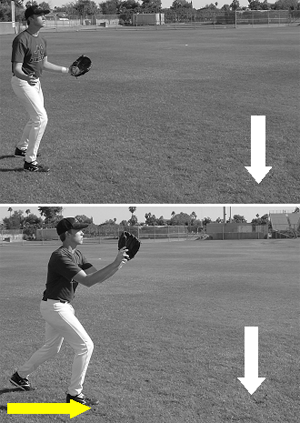| The Seven Sins of Outfield Play
The goal of outfielders is to cleanly field the ball and efficiently get it back to the infield. I have selected seven sins that outfielders do that prevent them from achieving that goal. And if you can get your outfielders to correct these problems, your defense will show marked improvement, and player injuries will decline. In this installment, we will look at the first three sins that outfielders commit most often. Sin #1: Drifting First, the outfielder is not in position to make the throw. Drifting puts outfielders on their heels, or their momentum is going away from the throwing target. Consequently, the player tries to speed up his transition from fielding to throwing. This puts undue pressure on throwing arms, and usually ends with a poor throw. The wind and the sun can also be a problem when drifting. Winds above an outfielder's head can be much stronger than at ground level. This moves the ball in uncertain ways and will usually result in a missed chance. The sun may also surprise an outfielder. Instead of getting to the catch zone early and evaluating the sun's position, he tries to time the catch, and finds the sun directly in line with the ball too late. The ball's spin is also a potential problem when drifting. Balls hit to center field usually have back-spin. Back-spin helps the ball travel farther, and drifting outfielders can be fooled and miss the catch. Side-spin is where the batter inside-outs the ball making it spin toward the foul line in either right or left fields. A drifting outfielder will never make up the distance to the ball in these cases. How to Correct Drifting The advantages of this are better balance, much better throws, and reduced possibility of arm injuries. Also, everyone is faster running forward than backward, which makes adjusting to the ball easier. Thirdly, the outfielder's momentum is now toward the throwing target which results in a quicker release of the ball. |
||
|
||
| Sin #2: Off-Balance Throws
|
||
The crow-hop should be used by outfielders for all throws - whether they are urgent or non-urgent throws. I even have my outfielders practice their crow-hops when just warming up. My guys found that not only did they throw with more accuracy and strength, but they also released the ball quicker. And every split-second in the outfield saves a lot of strides on the base paths. The steps to a proper crow-hop are:
No Sliding, Gliding, and Cha-Cha Moves Next, look out for what I call the Cha-Cha move. This is where the player will move his back leg behind him. This aligns his shoulders to the target, but takes his momentum off-target and reduces the velocity and accuracy of the throw. Finally, is the incorrect Gliding move. Some players will leap into the air and do a sort of scissor kick. Both legs come together like a ballet dancer and he lands on the back leg, and always off-balance. Sin #3: Side-Striding & Backpedaling Insist that your outfielders run with their upper body facing the intended catch target. They must also turn their heads enough so that both eyes are on the ball, if possible. This causes increased speed to the ball and less distortion of their vision. Backpedaling should never be used except on very unique plays. If the ball is hit on a line so hard that the only way the outfielder can get into position is to backpedal, then this is the only time backpedaling is acceptable. But even then, the correct way is usually better. Backpedaling makes the player's heels hit the ground after the toes do. When heels hit the ground they send shock waves through the body. This distorts the outfielder's vision and makes the ball seem to jump up and down. Secondly, backpedaling is just plain slow. Get your outfielders into the habit of always turning and running to the catch target. Sin #4: Not Charging the Ball What typically happens is the player charges the ball, becomes out of control, and misses the ground ball. Then they look at you like it's your fault - which it is. The proper way to teach charging the ball is to also stipulate that the player get himself under control in the catch zone. Under control usually means slowing down so their balance is never compromised. Next, the player should be taught to look for the good hop. As we all know there are no bad hops in the air. So the player should use their feet to adjust their forward momentum and catch the ground ball while it is coming down from its apex - not when it is bouncing up off the ground. Charging the ball has several advantages. If the player happens to bobble the ball, they are closer to the throwing target. This can stop an advancing runner in his tracks. Also, charging the ball allows the player to play the ball instead of the ball playing him. By moving his feet into a position to catch the ball closer to the infield AND with a good hop, the outfielder takes control of the base hit, and not the other way around. Lastly, all base coaches - especially third base coaches - look for two things when deciding to hold or send a runner. The catch and the distance of the throw. So if the outfielder has not charged the ball, the runner is waved home. But if the outfielder has charged hard to the ball, doubt creeps into the base coach's decision. From personal experience, I have prevented many more runners from scoring by charging the ball than I have thrown out runners at home. Sin #5: Lazy Jumps Train your outfielders to think like base stealers. The first three strides of any steal attempt are explosive - and outfielders should do the same. My tag line to my outfielders is "Gimme Three Steps". The first three steps can't be made up - no matter how much speed an outfielder has. These steps allow the player more time to read the ball. They also force the player to focus on reading the ball. Speed and directional adjustments are also easier after the explosive three steps. Finally, by getting your outfielders in the habit of "Gimme Three Steps", you'll find they charge the ball much better. Train your outfielders to stay low when getting their jumps. Track sprinters never stand straight up when coming out of the starting blocks, and outfielders should not as well. The player's torso should be bent at the waist to provide balance and explosive capability. This position allows the turning of the upper body, and the churning of legs and arms to happen much more quickly. All of these little things enhance the player's ability to get faster jumps. To get my players into this habit, during batting practice I tell them to go after every ball hit to their position, but only with the first three explosive strides. Shaggers are also notified that the outfielder will be starting after every ball, just not catching every ball. Then on every fourth or fifth chance, the outfielder will play the ball through the catch. Get your outfielders in the habit of thinking like base stealers. Sin #6: Catching Over the Wrong Shoulder Besides the obvious advantage of using two hands, catching fly balls over the throwing shoulder makes the transition from catch to throw much faster - and with better balance. The glove should be shoulder height, mostly over the throwing shoulder, and with the player's eyesight over the top of the glove. This gives the player better vision for the catch by aligning the glove and the ball. There is also a side benefit. It makes the player move his feet to get behind the ball (Sin #1: Drifting). There are very few Willie Mays type players in amateur baseball, so get your players to catch the ball correctly first. Sin #7: Lack of Communication Experience with all levels of outfielders has shown me that just saying the center fielder is the general is not enough. For instance, I had a player who thought that no matter where the ball was hit, it was the center fielder's ball (really!). And sometimes corner outfielders will yield to the center fielder despite themselves standing directly under the ball. And I have witnessed corner outfielders give up the chance despite the center fielder's momentum taking him away from the throwing target. All of these exceptions to the general rule should be discussed with your outfielders. They should also know that they have priority over infielders on pop-ups behind the infield. Teach your infielders to go hard after pop-ups until they are called off by the outfielder. Then train your outfielders to go hard until they know they won't catch the ball. Lastly, show them how back-spin and side-spin alters the ball's flight. Back-spin moves the ball further into the outfield. And side-spin moves the ball toward the foul lines. With all these situations and more, verbal communication is key. Outfielders should call for the ball loudly and at least three times. This helps prevent collisions when both outfielders call the ball - and neither of them hear the other. When an outfielder hears the other outfielder call the ball, he should answer to confirm it. "Take it! Take it! Take it!" is what I teach. Outfielders should communicate to tell fellow outfielders where to throw the ball - especially on tag plays. Speaking of which, outfielders should let the catching outfielder know if a runner is tagging or trying to take the extra base. They should also warn about the fence. I tell my guys to let the other outfielder know he is approaching the fence five strides before impact. This allows enough time for the pursuing outfielder to adjust. Outfielders should also direct traffic in certain situations. When an infielder and outfielder are converging on a pop-up, it's always better to yell the player's name who has called the ball. With all the signals and communications that are taught in the infield, don't forget to train your outfielders too. Defense wins championships.
|
||
|
About the Author... |
|
|
| Steven E. Michael played seven years of professional baseball in the Montreal Expos, Detroit Tigers, and Milwaukee Brewers organizations. He played collegiately at Arizona State University where he earned All-Western Athletic Conference, All-College World Series, and Sporting News All-America honors.
Mr. Michael co-owned the Telluride Baseball Camp for 10 years where he coached thousands of young players. He went on to coach several more years in other youth baseball camps. His book, How To Play Baseball Outfield: Techniques, Tips, and Drills to Learn the Outfield Position is available at http://www.stevenemichael.com. |





